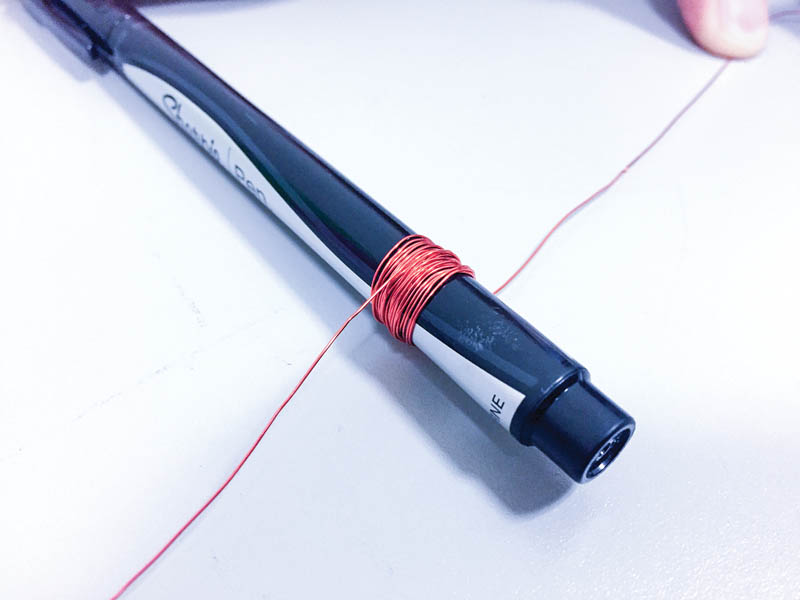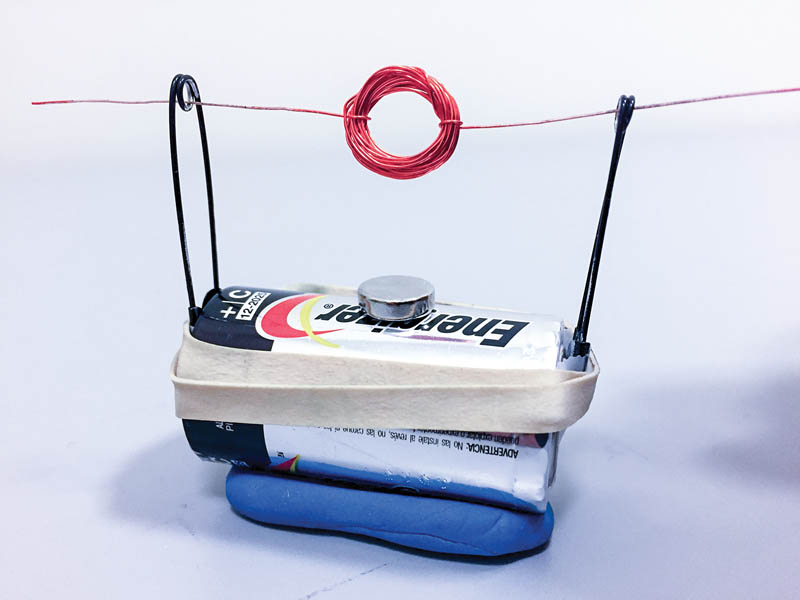
For each motor you'll need one C battery, a small but strong magnet, about three feet of magnet wire (buy it at Radio Shack, online, or any hardware store), two safety pins, a rubber band, sticky putty, and a small piece of sandpaper. Magnet wire has a plastic coating.
Wrap the wire around a circular object (like the battery, or better yet, a pen or pencil) and then slide it off to create a small coil (diameter ~1 cm), leaving the two ends sticking out as shown in Figures 1 and 2. We next need to remove the insulation from part of the ends. On one end, sand off the coating all the way around the wire. On the other end, sand the bottom side of the wire only.
Next, assemble the motor as shown in Figure 3. The safety pins are attached to the battery with the rubber band and the wire coil ends go through the holes in the ends of the safety pins. Here, we used a little sticky putty to hold the battery still on the table. Put the magnet on top of the battery, under the coil. Give your coil a little spin, and it should continue to spin on its own. (If it doesn't work, try spinning it the opposite direction.) You've made a motor!
When electricity is passed through a wire coil (as you are doing when you connect the coil to the battery), you create an electromagnetic field, which pushes the coil away from the magnet. 1,2 When you give the coil a spin, since one side of the wire is insulated, you break the circuit briefly, so the coil continues to rotate using its momentum. When the circuit is complete again, the magnetic field once again repels the coil, so it keeps spinning. The motor can continue to spin until the battery is dead!



An electrical current through any conductor creates a magnetic field. This was discovered (some say by accident) by Hans Christian Oersted in 1820 when he noticed a nearby compass needle was deflected when he turned on his electrical equipment. You can see the same effect with your coil circuit and a compass. 1,2
Wrapping the wire into a coil increases the strength of the magnetic field, so long as the moment of inertia remains small.
The principles that allow this motor to work are the same ones that govern all motors. These motors all turn electromagnetic energy into kinetic energy. Generators work the opposite way, by turning kinetic energy into electromagnetic energy (and in fact, you can turn motors into generators and vice versa, although sometimes it takes a little work).
Why isn't it working?
This relatively simple motor can take some patience. The answer to this most common question could be a number of issues. Try some troubleshooting:
Make sure your safety pins have good contact with the battery terminals.
Instructions for building an even simpler motor using a battery, a magnet, wire, and a drywall screw can be found here. Watch out with this one, and use eye protection as the screw could go flying.
http://www.evilmadscientist.com/2006/how-to-make-the-simplest-electric-motor/
Instructions for building a more advanced motor that doesn't require a push to get started can be found in The Physics Teacher, the journal from AAPT, “Development of a New Method for Assembling a Bipolar DC Motor as a Teaching Material.”
https://aapt.scitation.org/doi/10.1119/1.4981037
References